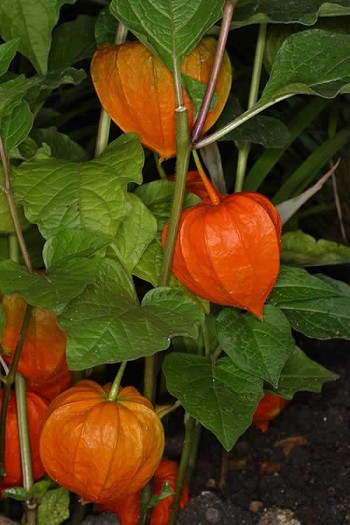
|
|
Physalis alkekengi (Chinese lantern)
|
Physalis - Physalis
spp.
Physalis is a genus of flowering plants in the nightshade family (Solanaceae), native to warm temperate and subtropical regions throughout the world. This genus has both ornamental and edible uses, depending on the
species, and it is widely cultivated all over the world. The genus is characterised by the small orange fruit similar in size, shape and structure to a small tomato, but partly or fully enclosed in a large papery husk derived from the calyx. Many Physalis species are called groundcherries. One name for Physalis peruviana is Cape gooseberry, not to be confused with the vast majority of gooseberries, which are of the genus Ribes.
They are herbaceous plants growing to 0.4–3 m tall, similar to the common tomato - a relative - but usually with a stiffer, more upright stem; they can be either annual or perennial. Most require full sun and fairly warm to hot temperatures. Some species are sensitive to frost, though others such as P. alkekengi (Chinese lantern) tolerate severe cold when dormant in
winter.
Physalis typically develops slightly hairy leaves, thick
stems, and delicate yellow to orange flowers. When fruit develops, it grows inside a
husk, and the color may vary: red, orange, and yellow are all common shades for Physalis
fruits, along with more exotic shades like purple.
The fruits of some species are edible, with an acidic kick like that of
tomatoes. Some have notes of tropical fruit like pineapples, while others have a more earthy
flavor. Physalis fruits can be eaten out of hand raw, sliced and thrown into
salads, used in salsas and sauces, cooked in stir fries, dried, and cooked in preserves and
jellies. Some varieties are more savory in nature, while others are very sweet. Tomatillos in particular are very popular in Latin
America, and they are rich in vitamin C, making them a great addition to the
diet.
In Chinese medicine, the Physalis is used as a remedy for abscesses, coughs, fevers and sore throats, among others. Smooth groundcherry (P. subglabrata) is considered a hallucinogenic plant by some, and its cultivation for other than ornamental purposes is outlawed in Louisiana by State Act 159. However, its use as a hallucinogen does not appear
widespread.
Physalis peruviana, commonly known as physalis, is indigenous to South
America, but was cultivated in South Africa in the region of the Cape of Good Hope during the 1800s, imparting its common
name, cape gooseberry.
The fruit is a small round berry about the size of a marble with numerous small yellow
seeds. It is bright yellow and sweet when ripe, making it ideal for snacks, pies or
jams. It is popular in fruit salads, sometimes combined with avocado.
Its most notable feature is the single papery pod that covers each berry. Because of the fruit's decorative
appearance, it is sometimes used in restaurants as an exotic garnish for
desserts. If the fruit is left inside the husks, its shelf life at room temperature is over 30–45
days.
Physalis alkekengi (Bladder cherry, Chinese lantern, Japanese
lantern, or Winter cherry; Japanese: hozuki), is a relative of P. peruviana (Cape
Gooseberry), easily identifiable by the larger, bright orange to red papery covering over its
fruit, which resemble Chinese lanterns. It is native from southern Europe east across southern Asia to
Japan. It is a herbaceous perennial plant growing to 40–60 cm tall, with spirally arranged leaves 6–12 cm long and 4–9 cm
broad. The flowers are white, with a five-lobed corolla 10–15 mm across, with an inflated basal calyx which matures into the papery orange fruit
covering, 4–5 cm long and broad.
It is a popular ornamental plant, though can be invasive with its wide-spreading root system sending up new shoots some distance from where it was originally
planted. It has escaped cultivation various places around the world. It has food and medicinal
uses, but because its side effects include miscarriage and abdominal pain, it must be used in moderation.[citation
needed] Like a number of other species in the genus Physalis, it contains a wide variety of
physalins.
The extinct Dacian language has left little traces, but in De Materia Medica by Pedanius
Dioscorides, a plant called Strychnos alikakabos (Óôñý÷íïò ÜëéêáêÜâïò) is
discussed, which was called kykolis (or cycolis) by the Dacians. Some have considered this plant to be Physalis
alkekengi, but Ashwagandha (Withania somnifera) has been proposed as an alternative candidate and indeed this
widely-traded medical plant seems to be a better match.
Physalis ixocarpa (Tomatillo) This perennial is native to Mexico and was used by the
Aztecs. Unlike other Physalis fruits (the Cape gooseberry and the ground cherry), the tomatillo completely fills the
Chinese-lantern-looking husk that is characteristic of physalis--in this case filled with
"little green tomatoes" (1-2" diameter) with a tart flavor that develops once you cook
them. It's a key ingredient of Mexican salsa verde.
Source:
http://en.wikipedia.org/wiki/Physalis
http://www.wisegeek.com/what-is-physalis.htm
http://en.wikipedia.org/wiki/Physalis_peruviana
http://en.wikipedia.org/wiki/Physalis_alkekengi
http://www.soupsong.com/ftomatil.html
